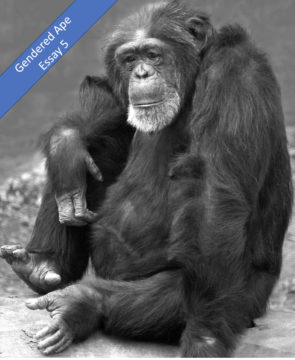Editor’s Note: Frans de Waal’s new book, Different: Gender Through the Eyes of a Primatologist, has generated some controversy and misunderstanding. He will address these issues in a series of short essays which will be published at 3QD and can all be seen in one place here. More comments on these essays can also be seen at Frans de Waal’s Facebook page.
by Frans de Waal

Florida Senator Rick Scott recently declared that “Men are men, women are women,” adding “we believe in science.” He was talking about transgender athletes.
I wish the senator did believe in science, though, because to reduce the gender palette to just two colors with nothing in between hardly works for biological sex and even less for gender expression and identity. It’s an outdated view.
The social roles of men and women are surrounded by persistent myths, often accompanied by the term “natural” as a stamp of approval and “unnatural” for patterns that we condemn. Most natural/unnatural distinctions have little grounding in biology, however. This is because biology is much more flexible than people assume. In the same way that no two trees of the same species are identical, nature is marked by high individual variability. Variability is what evolution works with. Since every individual comes with a unique genetic make-up, we can’t expect them to show the same sexual orientation and gender expression.
As American sexologist Milton Diamond is fond of putting it: “Nature loves variety, even though society hates it.”
Over five decades working with apes, I have known quite a few that acted atypically for their sex. These individuals form a minority, but nearly every group seems to have one. There are always males with less machismo than others, and always females who act tomboyish. Males who ignore the social hierarchy may be muscular giants, yet stay out of confrontations. They never reach the top, but also don’t sink to the bottom, because they are perfectly capable of defending themselves. The typical status game (and the social tensions and physical risks that it entails) is not for them.
As for the females, let me describe Donna, who grew up in a large grassy outdoor area with twenty other chimpanzees at the Field Station of the Emory Primate Center, outside of Atlanta. As a youngster, Donna always ran up to me if I walked by to engage me in a tickling match while giggling her hoarse chimpanzee laugh. She also frequently sought out the alpha male of the colony for wrestle play. This large male roughhoused daily with little males eager to test their strength against him. That Donna enjoyed the same games was the first hint that she was different.
Donna grew into a robust female who acted more masculine than any other I have known. Her genitals were those of a female, but she had the large head with rough-hewn facial features, sturdy hands and feet, and broad shoulders typical of males. Even her body hair reflected this. As in our species, male chimpanzees are the hairier sex. This allows them to look larger than life when they “go pilo” (from piloerection, or bristling hair). Donna could go pilo all over her body like a male. She furthermore acted as if she was part of the male world, charging by their side during noisy hooting displays. You’d swear you saw a full-grown male.
Individuals born as one sex, yet feeling to belong to the opposite sex, are known as transgender. Transgender persons usually turn this around and prioritize their felt identity. They were born as one sex, but inside the body of the other. We have no way of applying this to Donna, because we can’t know how she perceived her gender, yet she clearly was far less feminine than other females.
Science often focuses on typical behavior, thus ignoring exceptional individuals, but once we start looking for it I’m sure we’ll find plenty of gender diversity outside our own species. This also holds for sexual orientation. Homosexual behavior is well-documented throughout the animal kingdom. In some species, such as dolphins and bonobos it is so common that I prefer to label them bisexual: they don’t seem to have a clear preference for sex with one gender or the other. In other species, homosexual behavior is less common than heterosexual behavior, but we know for penguins, sheep, monkeys, apes, and tons of other animals that such behavior regularly occurs, and not only in captive settings.
The first reports that wild male and female macaques frequently mount members of their own sex were met with disbelief and attempts to explain this behavior away (the poor monkeys must have been confused about their partners’ gender or else were only engaging in “pseudo-” or “shamsex”), but evidence is now overwhelming that homosexual behavior is deliberate and serves important social functions, which is why nature has added pleasure to it. It’s no accident that both dolphins and bonobos have the largest clitorises in the animal kingdom, considerably larger than those of human females.
The most important difference with other species is not so much the degree of gender diversity in our species, but the way we react to it. Other primates show none of the discomfort and intolerance that LGBTQ+ individuals face in human society. Their societies accept other individuals as they come. I have never noticed hostility towards individuals escaping typical gender patterns.
FURTHER READING
LGBTQ+ stands for lesbian, gay, bisexual, transgender, queer, and others. The “plus” represents other sexual identities including pansexual and Two-Spirit.
Milton Diamond interview: https://www.youtube.com/watch?v=6MvNisJ7FoQ
The variable sexual behavior of bonobos is well-documented, and here is a 2021 report on chimpanzees in the journal Behaviour: “Sociosexual behaviour in wild chimpanzees occurs in variable contexts and is frequent between same-sex partners” (brill.com/view/journals/beh/158/3-4/article-p249_3.xml)
For further details and references to the literature, read “Different: Gender Through the Eyes of a Primatologist” (Norton, 2022). A video about the book can be seen here: https://fb.watch/ffbauZBzNb/
